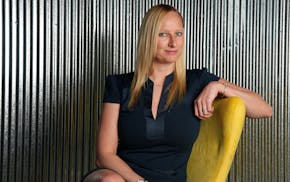A hormone treatment used in two last-gasp emergencies during the COVID-19 pandemic has shown enough promise that researchers are looking for new ways to administer it to patients with severe respiratory disorders — even while it remains experimental.
University of Minnesota researchers announced this week that they are exploring an aerosolized version of the liquid treatment that could be administered more easily and to more patients than the fluids that were dispensed down the breathing tubes of Bob Schlicht and Tim White. The two Minnesotans voluntarily received the experimental medication in summer 2020 after COVID left them struggling to breathe.
The researchers still need to convince the Food and Drug Administration that it is an effective treatment for acute respiratory distress syndrome (ARDS), a severe lung disorder caused by COVID-19 and other infectious diseases. But they are confident enough that they have created a startup company, Herald Therapeutics, and the university has obtained patents in the United States, Canada, China, India, and Mexico and is seeking one from the European Union.
The liquid version is given to patients who need mechanical ventilators to keep their lungs functioning, but an inhaled version could be given earlier on, before patients reach such advances stages of lung damage, said Dr. David Ingbar, a co-leader of the U research. Earlier use could improve outcomes from a condition that has been a problem long before the pandemic, he added.
"The public didn't really know about [ARDS], but it affects about 200,000 people per year in the U.S.," he said. "And at a 40 percent death rate, that means it kills about 80,000 people per year."
Ingbar and Dr. Timothy Rich have been studying for years the therapeutic potential of the hormone, called T3, that is produced in the thyroid gland. Studies of patients who died during the 2009 H1N1 influenza pandemic showed that they had depleted T3 levels. The doctors theorized that supplemental infusions could reduce harmful swelling and fluid buildup in the lungs, and launched their first clinical trial in 2019.
The coincidental emergence of COVID-19 helped and hindered the research. Supply problems during the pandemic limited their ability to provide the supplement, slowing the rollout of the trial, Ingbar said. On the other hand, the pandemic created a new pool of patients in respiratory distress to enroll, including Schlicht and White.
Schlicht grew severely ill during a road trip back from Florida, and because of pandemic restrictions his wife had to drop him off outside their local clinic in Grand Rapids. Schlicht, the first known COVID-19 case in Itasca County, deteriorated so rapidly that he was placed in a medicated coma and on a ventilator to keep his lungs functioning. He was rushed to St. Mary's Medical Center in Duluth, where Rich was on staff and recommended the hormone therapy. Schlicht's wife made the decision.
"I was given a five percent chance at life. That was kind of the decision-maker," said Schlicht, 72, whose daughter had already lost her partner to COVID in Europe in the early stages of the pandemic.
Few institutions have followed the U down this research path, though a team of Yale and Duke researchers found in animal studies that increased T3 levels can reduce fibrosis, or scarring inside the lungs.
T3 is widely available in medications that treat thyroid conditions and in dietary supplements. What makes the U approach so unorthodox is the administration of T3 in liquid form down the breathing tubes of patients on ventilators. Ingbar said that step is necessary in order to direct enough T3 at the lungs to reduce the level of swelling and fluid buildup in patients with ARDS. Administering that much of the supplement in pills or in injections into the bloodstream could produce toxic effects elsewhere in the body, he added.
Schlicht and White recovered from severe COVID-19 within days of receiving the liquid T3, though it is unclear how much the treatment played a role. They took part in an early Phase 1 study, which sought to prove that the treatment had potential, and was at least safe. But it couldn't prove efficacy because it didn't include a comparison group of patients who received standard therapy without the hormone supplement.
A Phase 2 study is underway that has so far has compared 13 patients with ARDS who received the liquid supplement with five patients who did not. A $350,000 grant from the Falk Medical Research Trust will allow the U researchers to explore a similar trial using the aerosol form.
All Schlicht knows is that he was near death in the hospital, and survived with strong lungs. He enjoys fishing at home in Coleraine, Minn., and trailer camping with his wife. He has had COVID-19 at least twice more, but neither case was as severe.
"I gained four extra years," he said. "I now have two grandsons that I never would have met."
White similarly believes a combination of the experimental treatment and faith helped him. His lungs are strong, but White said he has struggled with post-COVID fatigue. He lacked the energy to continue in his work as a corrections officer in Moose Lake, and moved to Georgia to be closer to family and avoid the toll that Minnesota winters take on his health.
The 55-year-old lost a fast-food job because he couldn't remain standing for an entire shift, but recently made his way to the top of Kennesaw Mountain outside of Atlanta. Survival allowed him to be a caregiver to his mother as she struggles with dementia.
Both men have encountered survival guilt, losing people close to them to COVID-19 who didn't have access to the experimental treatment.
"How did I win the lottery?" White asked.
U ethics rules required that Ingbar and Rich distance themselves from the day-to-day T3 research, now that they have a financial interest through their executive roles with the startup company. They can't directly recruit patients into the clinical trials or supervise the scientists who have taken over the studies, either.
Federal approval will ultimately demand a Phase 3 study with many more patients, and Ingbar said that will cost more than $40 million. The hope, he said, is that Phase 2 results, either with the liquid or aerosol versions, will be strong enough to entice investors and more grant support.
University of Minnesota's Osterholm spearheads effort to restore vaccine confidence

Competition for Twin Cities homes between $250K and $500K is fiercer than ever

Patina gift shops on path to employee ownership

